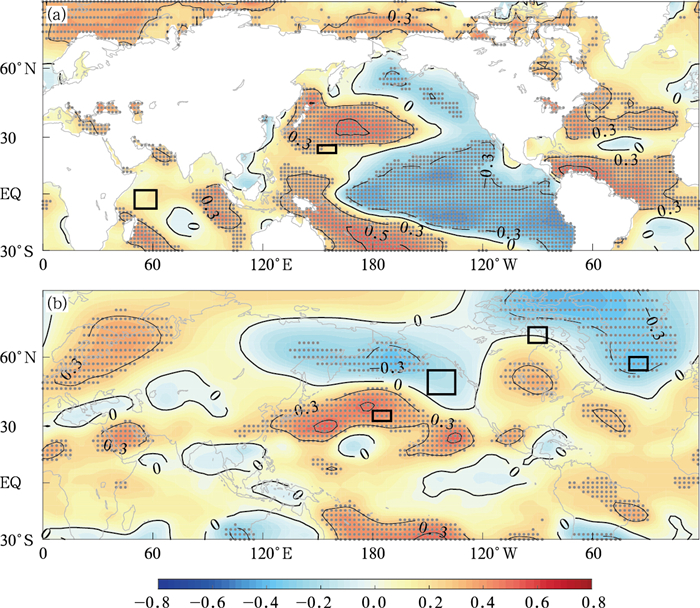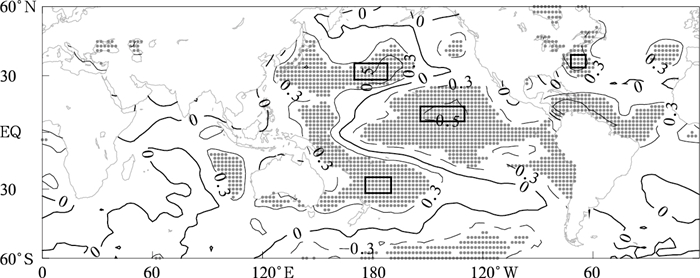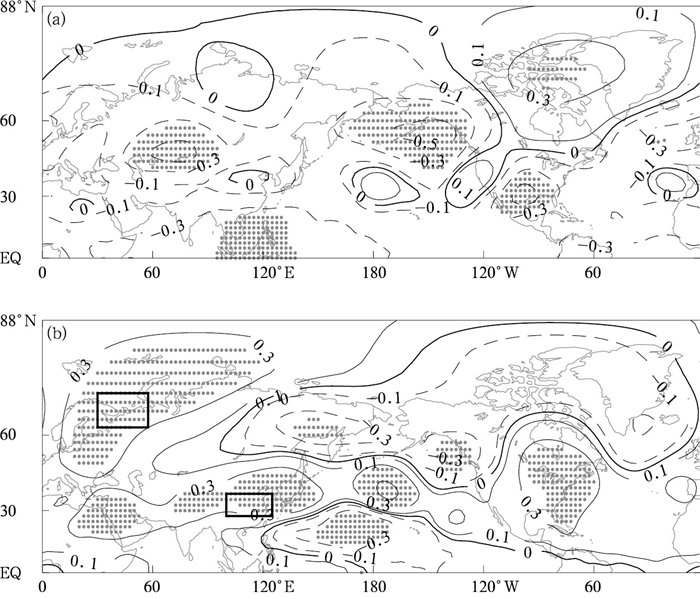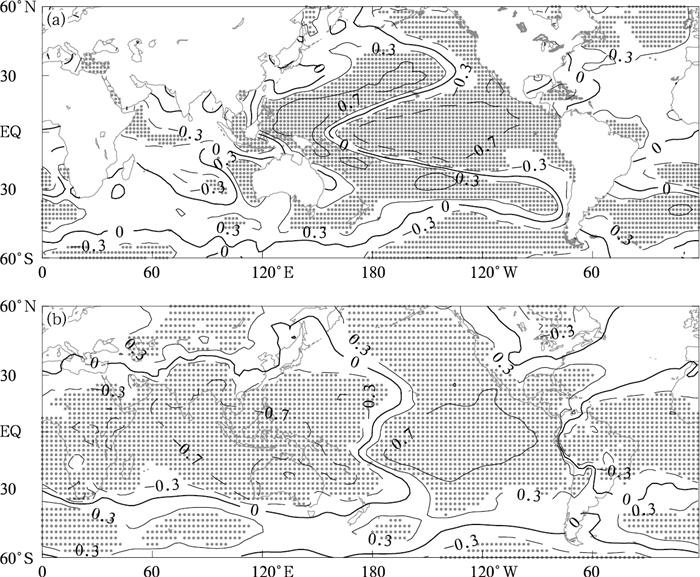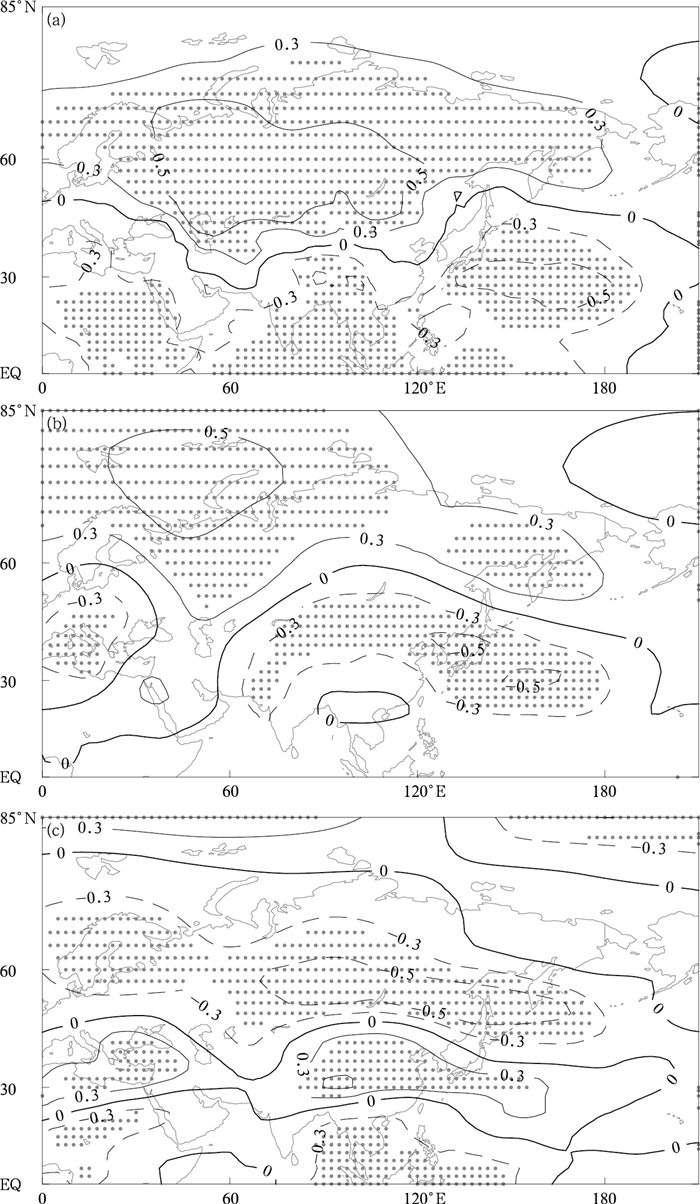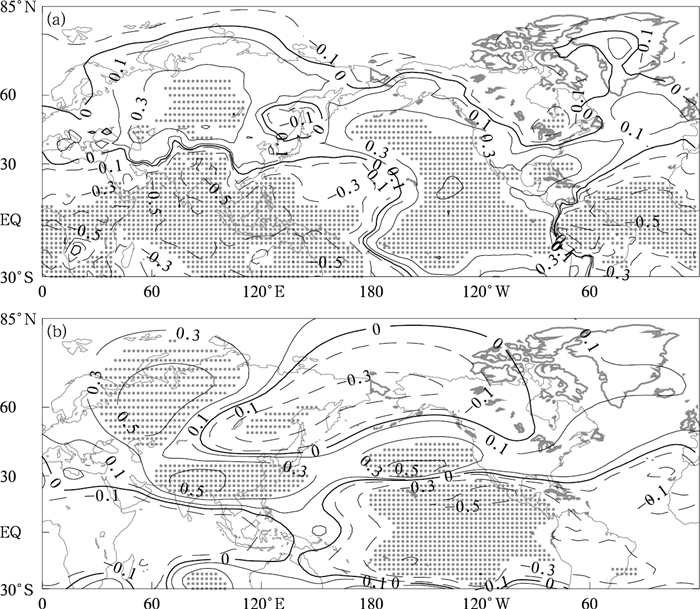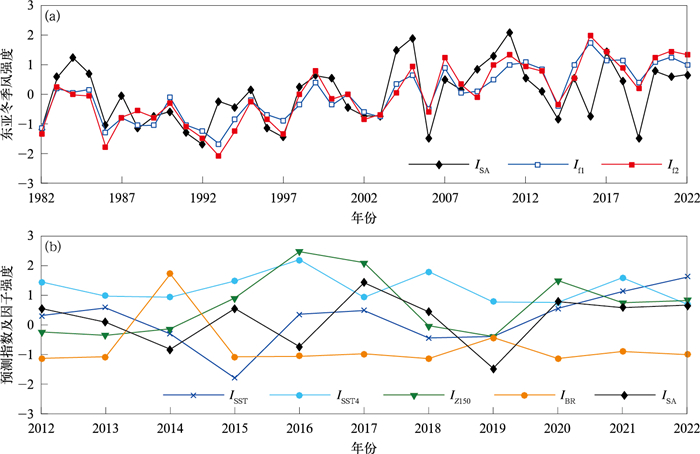A Statistical Prediction for East Asian Winter Monsoon Based on Sea-ice-air System
-
摘要: 东亚冬季风对东亚冬季的天气气候具有重要影响, 对其预测研究是冬季气候预测的关键问题。已有东亚冬季风强度指数(ISA)与东北冬季气温在年际、年代际尺度具有显著且稳定的相关关系, 但ISA的前兆信号在20世纪90年代末发生年代际转变, 对ISA的预测效果转差。在海-冰-气系统重新寻找影响ISA的前兆因子, 分析其与东亚冬季风的可能关联, 构建统计预测方法并开展交叉检验。结果表明:20世纪80年代后ISA与前期热带太平洋马蹄型结构的海温、墨西哥湾流区海温、平流层欧亚中高纬环流型呈显著正相关, 与巴伦支海海冰密集度呈显著负相关。以上前兆信号可通过冬季大气环流、海陆热力差等途径影响ISA, 预测模型拟合效果较好, 试报期间(2012—2022年)与实况的符号一致率达81.8%(9/11), 可用于当前年代际背景下东亚冬季风强度预测。Abstract: East Asian winter monsoon (EAWM) is one of the most crucial circulation systems in the Northern Hemisphere during winter, significantly influencing the weather and climate of East Asia. Therefore, predicting EAWM variations is considered as a key issue in winter climate prediction. The EAWM intensity index, as defined by Liu Shi (ISA) has shown a strong and consistent correlation with the interannual and interdecadal variations of winter temperature in Northeast China. However, the precursors influencing the EAWM (ISA) changed significantly with the decadal shift of the EAWM in the late 1990s. Predictions of EAWM have become less effective, and it is necessary to identify new predictors. Therefore, correlation analysis is conducted to identify the key factors influencing ISA based on the sea-ice-air system using reanalysis data produced by the National Centers for Environmental Prediction (NCEP) and the National Center for Atmospheric Research (NCAR), as well as optimum interpolation SST V2 data from the National Oceanic and Atmospheric Administration (NOAA). EAWM precursor factors are established and their possible interactions are discussed. Factors are used to construct a statistical prediction model using multiple linear regression method, which is evaluated through cross-validation. Results reveal a significant positive correlation between ISA and the horseshoe-shaped sea surface temperature (SST) pattern over the tropical Pacific autumn, as well as SST over the Gulf Stream and the Eurasian mid-high latitude circulation pattern in stratosphere. ISA shows a stronger and more consistent negative correlation with the sea ice concentration of the Barents Sea than that of the Kara Sea and Laptev Sea. These precursors influence ISA through land/sea thermal differences, winter atmospheric circulation patterns such as the East Asian trough, Ural blocking, and the East Asian subtropical westerly jet. The aforementioned prediction model demostrates a good fit and can be utilized to predict EAWM intensity under the current interdecadal background, with a consistency in the anomaly sign rate of 81.8% (9/11) during 11-year hindcast from 2012 to 2022. An analysis of two years of prediction failures reveals that the winter Arctic Oscillation (AO) forecasts, as well as the abrupt transition of the AO from autumn to winter, should be considered in the EAWM prediction process.
-
表 1 1982—2011年关键区海温指数及其与ISA的相关系数和符号一致率
Table 1 Correlation coefficients and consistency of the anomaly sign between ISA and key SST indices during 1982-2011
海温指数 范围 相关系数 符号一致率/% ISST1 黑潮延伸区(28°~36°N,170°E~172°W) 0.51Δ 70 ISST2 新西兰东北侧(32°~24°S,176°E~170°W) 0.49Δ 80 ISST3 Niño区(6°~14°N,130°~154°W) -0.56Δ 83 ISST4 墨西哥湾区(34°~40°N,64°~72°W) 0.66Δ 77 注:Δ表示相关系数达到0.05显著性水平。 表 2 各预测因子与ISA的相关系数、符号一致率
Table 2 Correlation and consistency of the anomaly sign between ISA and prediction factors
预测因子 与ISA的相关系数(1982—2011年) 符号一致率(1982—2011年)/% 符号一致率(2012—2022年)/% ISST 0.58ΔΔ 76.7 63.6 ISST4 0.66ΔΔ 73.3 63.6 IZ150 0.51Δ 76.7 72.7 IBR -0.63ΔΔ 73.3 72.7 注:Δ和ΔΔ分别表示相关系数达到0.05和0.01显著性水平。 -
[1] 丁一汇, 柳艳菊, 梁苏洁, 等.东亚冬季风的年代际变化及其与全球气候变化的可能联系.气象学报, 2014, 72(5):835-852. https://www.cnki.com.cn/Article/CJFDTOTAL-QXXB201405003.htmDing Y H, Liu Y J, Liang S J, et al. Interdecadal variability of the East Asian winter monsoon and its possible links to global climate change. Acta Meteor Sinica, 2014, 72(5): 835-852. https://www.cnki.com.cn/Article/CJFDTOTAL-QXXB201405003.htm [2] 韩永秋, 周连童, 黄荣辉. 中国冬半年极端低温事件的时空特征及其与东亚冬季风的关系. 气候与环境研究, 2021, 26(1): 1-17.Han Y Q, Zhou L T, Huang R H. Characteristics of the extreme low temperature events in China during boreal winter and its relationship to East Asian winter monsoon. Clim Environ Res, 2021, 26(1): 1-17. [3] 孙淑清, 陈隽. 异常东亚冬季风对夏季南海地区风场及热力场的影响. 气候与环境研究, 2000, 5(4): 400-416. https://www.cnki.com.cn/Article/CJFDTOTAL-QHYH200004006.htmSun S Q, Chen J. The variations of wind and thermodynamics fields in the South China Sea in summer during the anomaly winter monsoon. Clim Environ Res, 2000, 5(4): 400-416. https://www.cnki.com.cn/Article/CJFDTOTAL-QHYH200004006.htm [4] 胡鹏, 陈文. 南海夏季风爆发与前期东亚冬季风异常的关系以及ENSO的作用. 气候与环境研究, 2018, 23(4): 401-412. https://www.cnki.com.cn/Article/CJFDTOTAL-QHYH201804002.htmHu P, Chen W. The relationship between the East Asian winter monsoon anomaly and the subsequent summer monsoon onset over the South China Sea and the impact of ENSO. Clim Environ Res, 2018, 23(4): 401-412. https://www.cnki.com.cn/Article/CJFDTOTAL-QHYH201804002.htm [5] 曾琮, 胡斯团, 梁建茵, 等. 东亚冬季风异常与广东前汛期旱涝关系的初步分析. 应用气象学报, 2005, 16(5): 645-654. doi: 10.3969/j.issn.1001-7313.2005.05.011Zeng C, Hu S T, Liang J Y, et al. Preliminary researches on the relationship between anomalous winter monsoon circulation over East Asia and flood/drought from April to June in Guangdong. J Appl Meteor Sci, 2005, 16(5): 645-654. doi: 10.3969/j.issn.1001-7313.2005.05.011 [6] 刘实, 布和朝鲁, 陶诗言, 等. 东亚冬季风强度的统计预测方法研究. 大气科学, 2010, 34(1): 35-44. doi: 10.3878/j.issn.1006-9895.2010.01.04Liu S, Bueh C, Tao S Y, et al. A study of the statistical prediction method for the East Asian winter monsoon intensity. Chinese J Atmos Sci, 2010, 34(1): 35-44. doi: 10.3878/j.issn.1006-9895.2010.01.04 [7] 刘舸, 宋文玲, 朱艳峰. 一个反映中国大陆冬季气温变化的东亚冬季风指数的统计预测方法. 气象学报, 2013, 71(2): 275-285. https://www.cnki.com.cn/Article/CJFDTOTAL-QXXB201302010.htmLiu G, Song W L, Zhu Y F. A statistical prediction method for an East Asian winter monsoon index reflecting winter temperature changes over the Chinese mainland. Acta Meteor Sinica, 2013, 71(2): 275-285. https://www.cnki.com.cn/Article/CJFDTOTAL-QXXB201302010.htm [8] 朱艳峰. 一个适用于描述中国大陆冬季气温变化的东亚冬季风指数. 气象学报, 2008, 66(5): 781-788. doi: 10.3321/j.issn:0577-6619.2008.05.011Zhu Y F. An index of East Asian winter monsoon applied to description the Chinese mainland winter temperature changes. Acta Meteor Sinica, 2008, 66(5): 781-788. doi: 10.3321/j.issn:0577-6619.2008.05.011 [9] 邵鹏程, 李栋梁. 东亚冬季风指数的分类和比较. 气象科学, 2012, 32(2): 226-235. doi: 10.3969/2012jms.0018Shao P C, Li D L. Classification and comparison of East Asian winter monsoon indices. J Meteor Sci, 2012, 32(2): 226-235. doi: 10.3969/2012jms.0018 [10] 刘实. 确定东亚冬季风强度指数的一种方法探讨. 地理科学, 2007, 27(增刊Ⅰ): 10-18.Liu S. A method for determining intensity index of East Asian winter monsoon. Scientia Geographic Sinica, 2007, 27(Suppl Ⅰ): 10-18. [11] 刘实, 隋波, 涂钢, 等. 我国东北地区冬季气温变化的东亚冬季风背景. 应用气象学报, 2014, 25(1): 11-21. http://qikan.camscma.cn/article/id/20140102Liu S, Sui B, Tu G, et al. The East Asian winter monsoon background on the variation of winter air temperature in Northeast China. J Appl Meteor Sci, 2014, 25(1): 11-21. http://qikan.camscma.cn/article/id/20140102 [12] 邵祺多, 涂钢, 苏丽欣, 等. 2008—2019年东亚冬季风强度的预测检验及结果分析. 气象灾害防御, 2022, 29(2): 1-7. https://www.cnki.com.cn/Article/CJFDTOTAL-JLQX202202001.htmShao Q D, Tu G, Su L X, et al. Forecast test and result analysis of East Asian winter wind intensity in 2008-2019. Meteor Disaster Prev, 2022, 29(2): 1-7. https://www.cnki.com.cn/Article/CJFDTOTAL-JLQX202202001.htm [13] 施晓晖, 徐祥德, 谢立安. 近40年来东亚冬季风的年代际时空变化趋势. 大气科学, 2007, 31(4): 747-756. doi: 10.3878/j.issn.1006-9895.2007.04.19Shi X H, Xu X D, Xie L A. Interdecadal spatial-temporal change trend of East Asian winter monsoon in the last 40 years. Chinese J Atmos Sci, 2007, 31(4): 747-756. doi: 10.3878/j.issn.1006-9895.2007.04.19 [14] 黄荣辉, 刘永, 皇甫静亮, 等. 20世纪90年代末东亚冬季风年代际变化特征及其内动力成因. 大气科学, 2014, 38(4): 627-644. https://www.cnki.com.cn/Article/CJFDTOTAL-DQXK201404003.htmHuang R H, Liu Y, Huangfu J L, et al. Characteristics and internal dynamical causes of the interdecadal variability of East Asian winter monsoon near the late 1990s. Chinese J Atmos Sci, 2014, 38(4): 627-644. https://www.cnki.com.cn/Article/CJFDTOTAL-DQXK201404003.htm [15] 肖晓, 陈文, 范广洲, 等. 20世纪90年代末东亚冬季风年代际变化的外强迫因子分析. 气候与环境研究, 2016, 21(2): 197-209. https://www.cnki.com.cn/Article/CJFDTOTAL-QHYH201602008.htmXiao X, Chen W, Fan G Z, et al. Possible external forcing factors for the interdecadal change in the East Asian winter monsoon around the late 1990s. Clim Environ Res, 2016, 21(2): 197-209. https://www.cnki.com.cn/Article/CJFDTOTAL-QHYH201602008.htm [16] Jeong J H, Ou T H, Linderholm H W, et al. Recent recovery of the Siberian High intensity. J Geophys Res Atmos, 2011, 116(D23). DOI: 10.1029/2011JD015904. [17] Wang L, Chen W. The East Asian winter monsoon: Re-amplification in the mid-2000s. Chinese Sci Bull, 2014, 59(4): 430-436. doi: 10.1007/s11434-013-0029-0 [18] Kalnay E, Kanamitsu M, Kistler R, et al. The NCEP/NCAR 40-year reanalysis project. Bull Amer Meteor Soc, 1996, 77(3): 437-471. doi: 10.1175/1520-0477(1996)077<0437:TNYRP>2.0.CO;2 [19] Reynolds R W, Rayner N A, Smith T M, et al. An improved in situ and satellite SST analysis for climate. J Climate, 2002, 15(13): 1609-1625. doi: 10.1175/1520-0442(2002)015<1609:AIISAS>2.0.CO;2 [20] Hersbach H, Bell B, Berrisford P, et al. The ERA5 global reanalysis. Q J R Meteor Soc, 2020, 146(730): 1999-2049. doi: 10.1002/qj.3803 [21] 范丽军, 符淙斌, 陈德亮. 统计降尺度法对华北地区未来区域气温变化情景的预估. 大气科学, 2007, 31(5): 887-897. doi: 10.3878/j.issn.1006-9895.2007.05.12Fan L J, Fu C B, Chen D L. Estimation of local temperature change scenarios in North China using statistical downscaling method. Chinese J Atmos Sci, 2007, 31(5): 887-897. doi: 10.3878/j.issn.1006-9895.2007.05.12 [22] Michaelsen J. Cross-validation in statistical climate forecast models. J Appl Meteor Clim, 1987, 26(11): 1589-1600. doi: 10.1175/1520-0450(1987)026<1589:CVISCF>2.0.CO;2 [23] 贺圣平, 王会军. 东亚冬季风综合指数及其表达的东亚冬季风年际变化特征. 大气科学, 2012, 36(3): 523-538. https://www.cnki.com.cn/Article/CJFDTOTAL-DQXK201203007.htmHe S P, Wang H J. An integrated East Asian winter monsoon index and its interannual variability. Chinese J Atmos Sci, 2012, 36(3): 523-538. https://www.cnki.com.cn/Article/CJFDTOTAL-DQXK201203007.htm [24] 袁福香, 穆佳, 高岩, 等. 覆盖与揭膜时间对越冬人参和西洋参出苗影响. 应用气象学报, 2023, 34(6): 729-738. doi: 10.11898/1001-7313.20230608Yuan F X, Mu J, Gao Y, et al. Effects of covering and uncovering date on seedling emergence of overwintering ginseng and American ginseng. J Appl Meteor Sci, 2023, 34(6): 729-738. doi: 10.11898/1001-7313.20230608 [25] 宋艳玲, 周广胜, 郭建平, 等. 北方冬小麦冬季冻害及播期延迟应对. 应用气象学报, 2022, 33(4): 454-465. doi: 10.11898/1001-7313.20220406Song Y L, Zhou G S, Guo J P, et al. Freezing injury of winter wheat in northern China and delaying sowing date to adapt. J Appl Meteor Sci, 2022, 33(4): 454-465. doi: 10.11898/1001-7313.20220406 [26] 郭安红, 王纯枝, 邓环环, 等. 草地贪夜蛾迁飞大气动力条件分析及过程模拟. 应用气象学报, 2022, 33(5): 541-554. doi: 10.11898/1001-7313.20220503Guo A H, Wang C Z, Deng H H, et al. Atmospheric dynamics analysis and simulation of the migration of fall armyworm. J Appl Meteor Sci, 2022, 33(5): 541-554. doi: 10.11898/1001-7313.20220503 [27] Yang S, Lau K M, Kim K M. Variations of the East Asian jet stream and Asian-Pacific-American winter climate anomalies. J Climate, 2002, 15(3): 306-325. doi: 10.1175/1520-0442(2002)015<0306:VOTEAJ>2.0.CO;2 [28] Sato K, Inoue J, Watanabe M. Influence of the Gulf Stream on the Barents Sea ice retreat and Eurasian coldness during early winter. Environ Res Lett, 2014, 9(8). DOI: 10.1088/1748-9326/9/8/084009. [29] 高登义, 武炳义. 北半球海-冰-气系统的10年振荡及其振源初探. 大气科学, 1998, 22(2): 137-144. doi: 10.3878/j.issn.1006-9895.1998.02.02Gao D Y, Wu B Y. Preliminary study on decadal oscillation and its oscillation source of the sea-ice-air system in the Northern Hemisphere. Chinese J Atmos Sci, 1998, 22(2): 137-144. doi: 10.3878/j.issn.1006-9895.1998.02.02 [30] 武炳义, 黄荣辉, 高登义. 冬季北极喀拉海、巴伦支海海冰面积变化对东亚冬季风的影响. 大气科学, 1999, 23(3): 267-275. doi: 10.3878/j.issn.1006-9895.1999.03.02Wu B Y, Huang R H, Gao D Y. The impact of variation of sea-ice extent in the Kara Sea and the Barents Seas in winter on the winter monsoon over East Asia. Chinese J Atmos Sci, 1999, 23(3): 267-275. doi: 10.3878/j.issn.1006-9895.1999.03.02 [31] 武炳义, 卞林根, 张人禾. 冬季北极涛动和北极海冰变化对东亚气候变化的影响. 极地研究, 2004, 16(3): 211-220. https://www.cnki.com.cn/Article/CJFDTOTAL-JDYZ200403006.htmWu B Y, Bian L G, Zhang R H. Effects of the winter AO and the Arctic sea ice variations on climate variation over East Asia. Chinese J Polar Res, 2004, 16(3): 211-220. https://www.cnki.com.cn/Article/CJFDTOTAL-JDYZ200403006.htm [32] Wu B Y, Su J Z, D'Arrigo R. Patterns of Asian winter climate variability and links to Arctic Sea ice. J Climate, 2015, 28(17): 6841-6858. doi: 10.1175/JCLI-D-14-00274.1 [33] 武炳义. 北极海冰融化影响东亚冬季天气和气候的研究进展以及学术争论焦点问题. 大气科学, 2018, 42(4): 786-805. https://www.cnki.com.cn/Article/CJFDTOTAL-DQXK201804006.htmWu B Y. Progresses in the impact study of Arctic sea ice loss on wintertime weather and climate variability over East Asia and key academic disputes. Chinese J Atmos Sci, 2018, 42(4): 786-805. https://www.cnki.com.cn/Article/CJFDTOTAL-DQXK201804006.htm [34] Wu B Y, Huang R H, Gao D Y. Effects of variation of winter sea-ice area in Kara and Barents seas on East Asia winter monsoon. J Meteor Res, 1999, 13(2): 141-153. [35] Wu B Y, Su J Z, Zhang R H. Effects of autumn-winter Arctic sea ice on winter Siberian High. Chinese Sci Bull, 2011, 56(30): 3220-3228. doi: 10.1007/s11434-011-4696-4 [36] Petoukhov V, Semenov V A. A link between reduced Barents-Kara sea ice and cold winter extremes over northern continents. J Geophys Res, 2010, 115(D21). DOI: 10.1029/2009JD013568. [37] Baldwin M P, Thompson D W J, Shuckburgh E F, et al. Weather from the stratosphere?. Science, 2003, 301(5631): 317-319. doi: 10.1126/science.1085688 [38] 施宁, 布和朝鲁. 中国大范围持续性极端低温事件的一类平流层前兆信号. 大气科学, 2015, 39(1): 210-220. https://www.cnki.com.cn/Article/CJFDTOTAL-DQXK201501016.htmShi N, Bueh C. A specific stratospheric precursory signal for the extensive and persistent extreme cold events in China. Chinese J Atmos Sci, 2015, 39(1): 210-220. https://www.cnki.com.cn/Article/CJFDTOTAL-DQXK201501016.htm [39] Screen J A, Simmonds I. Exploring links between Arctic amplification and mid-latitude weather. Geophys Res Lett, 2013, 40(5): 959-964. doi: 10.1002/grl.50174 [40] Jhun J G, Lee E J. A new East Asian winter monsoon index and associated characteristics of the winter monsoon. J Climate, 2004, 17(4): 711-726. doi: 10.1175/1520-0442(2004)017<0711:ANEAWM>2.0.CO;2 [41] Honda M, Inoue J, Yamane S. Influence of low Arctic sea-ice minima on anomalously cold Eurasian winters. Geophys Res Lett, 2009, 36(8). DOI: 10.1029/2008gl037079. [42] Zhang P, Wu Z W, Li J P, et al. Seasonal prediction of the northern and southern temperature modes of the East Asian winter monsoon: The importance of the Arctic sea ice. Climate Dyn, 2020, 54(7): 3583-3597. [43] Gong D Y, Wang S W, Zhu J H. East Asian winter monsoon and Arctic oscillation. Geophys Res Lett, 2001, 28(10): 2073-2076. [44] Tian B Q, Fan K, Yang H Q. East Asian winter monsoon forecasting schemes based on the NCEP's climate forecast system. Climate Dyn, 2018, 51(7): 2793-2805. [45] 郭其蕴. 东亚冬季风的变化与中国气温异常的关系. 应用气象学报, 1994, 5(2): 218-225. http://qikan.camscma.cn/article/id/19940238Guo Q Y. Relationship between East Asian winter monsoon variation and China temperature anomalies. J Appl Meteor Sci, 1994, 5(2): 218-225. http://qikan.camscma.cn/article/id/19940238 [46] 郑倩, 高猛. 西北太平洋热带气旋生成客观预测模型. 应用气象学报, 2022, 33(5): 594-603. doi: 10.11898/1001-7313.20220507Zheng Q, Gao M. An objective prediction model of tropical cyclone formation in the Northwest Pacific. J Appl Meteor Sci, 2022, 33(5): 594-603. doi: 10.11898/1001-7313.20220507 [47] 米前川, 高西宁, 李玥, 等. 深度学习方法在干旱预测中的应用. 应用气象学报, 2022, 33(1): 104-114. doi: 10.11898/1001-7313.20220109Mi Q C, Gao X N, Li Y, et al. Application of deep learning method in drought prediction. J Appl Meteor Sci, 2022, 33(1): 104-114. doi: 10.11898/1001-7313.20220109 [48] 张智超, 周放, 张浩鑫, 等. BCC_CSM1.1m对冬季典型环流系统的预测评估. 应用气象学报, 2023, 34(1): 27-38. doi: 10.11898/1001-7313.20230103Zhang Z C, Zhou F, Zhang H X, et al. Predication of typical winter circulation systems based on BCC_CSM1.1m model. J Appl Meteor Sci, 2023, 34(1): 27-38. doi: 10.11898/1001-7313.20230103 -


 设为首页
设为首页 加入收藏
加入收藏


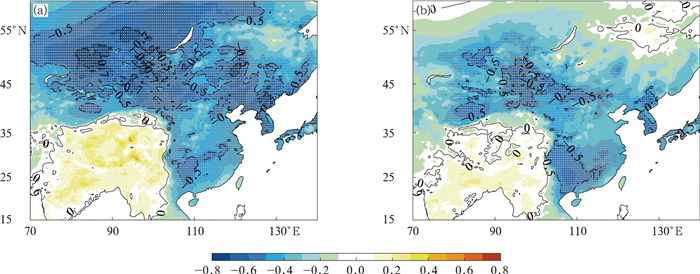
 下载:
下载:
